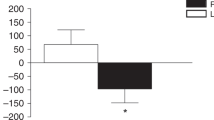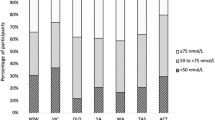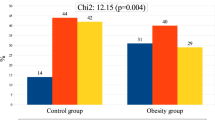Abstract
Objective: To evaluate the effects of nutrient intake and vitamin D status on markers of type I collagen formation and degradation in adolescent boys and girls.
Design: Cross-sectional study.
Setting: Canton of Vaud, West Switzerland.
Subjects: A total of 92 boys and 104 girls, aged 11–16 y. Data were collected on height, weight, pubertal status (self-assessment of Tanner stage), nutrient intake (3-day dietary record) and fasting serum concentration of 25-hydroxyvitamin D (25OHD), and markers of collagen formation (P1NP) and degradation (serum C-terminal telopeptides: S-CTX).
Results: Tanner stage was a significant determinant of P1NP in boys and girls and S-CTX in girls. Of the nutrients examined, only the ratio of calcium to phosphorus (Ca/P) was positively associated with P1NP in boys, after adjustment for pubertal status. 25OHD decreased significantly at each Tanner stage in boys. Overall, 15% of boys and 17% of girls were identified as being vitamin D insufficient (serum 25OHD <30 nmol/l), with the highest proportion of insufficiency at Tanner stage 4–5 (29%) in boys and at Tanner stage 3 (24%) in girls. A significant association was not found between 25OHD and either bone turnover marker, nor was 25OHD insufficiency associated with higher concentrations of the bone turnover markers.
Conclusions: The marked effects of puberty on bone metabolism may have obscured any possible effects of diet and vitamin D status on markers of bone metabolism. The mechanistic basis for the positive association between dietary Ca/P ratio and P1NP in boys is not clear and may be attributable to a higher Ca intake per se, a critical balance between Ca and P intake or higher dairy product consumption. A higher incidence of vitamin D insufficiency in older adolescents may reflect a more sedentary lifestyle or increased utilisation of 25OHD, and suggests that further research is needed to define their requirements.
Sponsorship: Nestec Ltd and The Swiss Foundation for Research in Osteoporosis.
This is a preview of subscription content, access via your institution
Access options
Subscribe to this journal
Receive 12 print issues and online access
$259.00 per year
only $21.58 per issue
Buy this article
- Purchase on Springer Link
- Instant access to full article PDF
Prices may be subject to local taxes which are calculated during checkout

Similar content being viewed by others
References
Ballabriga A (2000): Morphological and physiological changes during growth: an update. Eur. J. Clin. Nutr. 54 (Suppl 1), S1–S6.
Baron R (2003): General Principles of Bone Biology. Primer on the Metabolic Bone Diseases and Disorders of Mineral Metabolism. Washington: American Society for Bone and Mineral Research.
Cadogan J, Blumsohn A, Barker ME & Eastell R (1998): A longitudinal study of bone gain in pubertal girls: anthropometric and biochemical correlates. J. Bone Miner. Res. 13, 1602–1612.
Cadogan J, Eastell R, Jones N & Barker ME (1997): Milk intake and bone mineral acquisition in adolescent girls: randomised, controlled intervention trial. BMJ 315, 1255–1260.
Cavadini C, Decarli B, Dirren H, Cauderay M, Narring F & Michaud P (1999): Assessment of adolescent food habits in Switzerland. Appetite 32, 97–106.
Department of Health (1991): COMA Report on Dietary Reference Values for Food, Energy and Nutrients for the UK. London: HMSO.
Cooper C, Campion G & Melton III LJ (1992): Hip fractures in the elderly: a world-wide projection. Osteoporos. Int. 2, 285–289.
Decarli B, Cavadini C, Grin J, Blondel-Lubrano A, Narring F & Michaud PA (2000): Food and nutrient intakes in a group of 11 to 16 year old Swiss teenagers. Int. J. Vitam. Nutr. Res. 70, 139–147.
Dibba B, Prentice A, Ceesay M, Stirling DM, Cole TJ & Poskitt EM (2000): Effect of calcium supplementation on bone mineral accretion in gambian children accustomed to a low-calcium diet. Am. J. Clin. Nutr. 71, 544–549.
Duke PM, Litt IF & Gross RT (1980): Adolescents' self-assessment of sexual maturation. Pediatrics 66, 918–920.
El-Hajj Fuleihan G, Nabulsi M, Choucair M, Salamoun M, Hajj Shahine C, Kizirian A & Tannous R (2001): Hypovitaminosis D in healthy schoolchildren. Pediatrics 107, E53.
Fares JE, Choucair M, Nabulsi M, Salamoun M, Shahine CH & El-Hajj Fuleihan G (2003): Effect of gender, puberty, and vitamin D status on biochemical markers of bone remodeling. Bone 33, 242–247.
Favier J-C, Ireland-Ripert J, Toque C & Feinberg M (1995): Répertoire général des aliments. Table de composition, 2ème ed. Paris: Lavoisier Technique & Documentation.
Ginty F, Stear SJ, Jones SC, Prentice A, Stirling DM, Bennett J, Laidlaw A & Cole TJ (2002a): The effects of a 15 month calcium and exercise intervention on markers of bone and calcium metabolism in 16–18 year old girls. J. Bone Miner. Res. 17, 1341.
Ginty F, Stear SJ, Jones SC, Stirling DM, Bennett J, Laidlaw A, Cole TJ & Prentice A (2002b): Impact of calcium supplementation on markers of bone and calcium metabolism in 16–18 year old boys. J. Bone Miner. Res. 17, S178.
Goldberg GR, Black AE, Jebb SA, Cole TJ, Murgatroyd PR, Coward WA & Prentice AM (1991): Critical evaluation of energy intake data using fundamental principles of energy physiology: 1. Derivation of cut-off limits to identify under-recording. Eur. J. Clin. Nutr. 45, 569–581.
Gregory J, Lowe S, Bates CJ, Prentice A, Jackson LV, Smithers G, Wenlock R & Farron M (2000): National Diet and Nutrition Survey: Young People Aged 4 to 18 Years. London: The Stationery Office.
Guillemant J, Cabrol S, Allemandou A, Peres G & Guillemant S (1995): Vitamin D-dependent seasonal variation of PTH in growing male adolescents. Bone 17, 513–516.
Guillemant J, Cabrol S, Allemandou A, Peres G & Guillemant S (1996): Seasonal variations of vitamin D and parathyroid hormone levels in adolescents during the pubertal growth phase. Arch. Pediatr. 3, 396–397.
Heaney RP, McCarron DA, Dawson-Hughes B, Oparil S, Berga SL, Stern JS, Barr SI & Rosen CJ (1999): Dietary changes favorably affect bone remodelling in older adults. J. Am. Diet. Assoc. 99, 1228–1233.
Holick MF (1996): Vitamin D and bone health. J. Nutr. 126, 1159S–1164S.
Johansen JS, Giwercman A, Hartwell D, Nielsen CT, Price PA, Christiansen C & Skakkebaek NE (1988): Serum bone Gla-protein as a marker of bone growth in children and adolescents: correlation with age, height, serum insulin-like growth factor I, and serum testosterone. J. Clin. Endocrinol. Metab. 67, 273–278.
Johnston Jr CC, Miller JZ, Slemenda CW, Reister TK, Hui S, Christian JC & Peacock M (1992): Calcium supplementation and increases in bone mineral density in children. N. Engl. J. Med. 327, 82–87.
Lehtonen-Veromaa MK, Mottonen TT, Nuotio IO, Irjala KM, Leino AE & Viikari JS (2002): Vitamin D and attainment of peak bone mass among peripubertal Finnish girls: a 3-y prospective study. Am. J. Clin. Nutr. 76, 1446–1453.
Lips P (2001): Vitamin D deficiency and secondary hyperparathyroidism in the elderly: consequences for bone loss and fractures and therapeutic implications. Endocr. Rev. 22, 477–501.
Lips P, Wierzinga A, Van Ginkel FC, Jongen MJM & Netelenbos JC (1988): The effect of vitamin D supplementation on vitamin D status and parathyroid function in elderly subjects. J. Clin. Endocrinol. Metab. 67, 644–650.
Lloyd T, Andon MB, Rollings N, Martel JK, Landis JR, Demers LM, Eggli DF, Kieselhorst K & Kulin HE (1993): Calcium supplementation and bone mineral density in adolescent girls. JAMA 270, 841–844.
Matkovic V (1991): Calcium metabolism and calcium requirements during skeletal modeling and consolidation of bone mass. Am. J. Clin. Nutr. 54, 245S–260S.
McCarthy TL, Centrella M & Canalis E (1989): Insulin-like growth factor (IGF) and bone. Connect. Tissue Res. 20, 277–282.
Meunier PJ (2001): Vitamin D insufficiency: reappraisal of its definition threshold and bone consequences. In Nutritional Aspects of Osteoporosis, eds P Burckhardt, B Dawson-Hughes & RP Heaney, pp 167–171. San Diego, CA: Academic Press.
Mora S, Prinster C, Proverbio MC, Bellini A, de Poli SC, Weber G, Abbiati G & Chiumello G (1998): Urinary markers of bone turnover in healthy children and adolescents: age-related changes and effect of puberty. Calcif. Tissue Int. 63, 369–374.
Narring F, Cauderay M, Cavadini C & Michaud PA (1999): Physical fitness and sport activity of children and adolescents: methodological aspects of a regional survey. Soz. Praventivmed. 44, 44–54.
Neville CE, Robson PJ, Murray LJ, Strain JJ, Twisk J, Gallagher AM, McGuinness M, Cran GW, Ralston SH & Boreham CA (2002): The effect of nutrient intake on bone mineral status in young adults: the Northern Ireland young hearts project. Calcif. Tissue Int. 70, 89–98.
New SA, Robins SP, Campbell MK, Martin JC, Garton MJ, Bolton-Smith C, Grubb DA, Lee SJ & Reid DM (2000): Dietary influences on bone mass and bone metabolism: further evidence of a positive link between fruit and vegetable consumption and bone health? Am. J. Clin. Nutr. 71, 142–151.
Outila TA, Karkkainen MU & Lamberg-Allardt CJ (2001): Vitamin D status affects serum parathyroid hormone concentrations during winter in female adolescents: associations with forearm bone mineral density. Am. J. Clin. Nutr. 74, 206–210.
Prentice A, Stear SJ, Ginty F, Jones SC, Mills L & Cole TJ (2002): Calcium supplementation increases height and bone mass of 16–18 year old boys. J. Bone Miner. Res. 17, S397.
Risteli J & Risteli L (1997): Assays of type I procollagen domains and collagen fragments: problems to be solved and future trends. Scand. J. Clin. Lab. Invest. Suppl. 227, 105–113.
Rosenquist C, Fledelius C, Christgau S, Pedersen BJ, Bonde M, Qvist P & Christiansen C (1998): Serum CrossLaps One Step ELISA. First application of monoclonal antibodies for measurement in serum of bone-related degradation products from C-terminal telopeptides of type I collagen. Clin. Chem. 44, 2281–2289.
Rotteveel J, Schoute E & Delemarre-van de Waal HA (1997): Serum procollagen I carboxyterminal propeptide (PICP) levels through puberty: relation to height velocity and serum hormone levels. Acta Paediatr. 86, 143–147.
Slemenda CW, Peacock M, Hui S, Zhou L & Johnston CC (1997): Reduced rates of skeletal remodeling are associated with increased bone mineral density during the development of peak skeletal mass. J. Bone Miner. Res. 12, 676–682.
Sojka JE & Weaver CM (1995): Magnesium supplementation and osteoporosis. Nutr. Rev. 53, 71–74.
Sorva R, Anttila R, Siimes MA, Sorva A, Tahtela R & Turpeinen M (1997): Serum markers of collagen metabolism and serum osteocalcin in relation to pubertal development in 57 boys at 14 years of age. Pediatr. Res. 42, 528–532.
Standing Committee on the Scientific Evaluation of Dietary Reference Intakes FaNB, Institute of Medicine (1997): Dietary Reference Intakes for Calcium, Phosphorus, Magnesium, Vitamin D and Fluoride. Washington DC: National Academy Press.
Stear SJ, Prentice A, Jones SC & Cole TJ (2003): Effect of a calcium and exercise intervention on bone mineral status of 16–18 year old adolescent girls. Am. J. Clin. Nutr. 77, 985–992.
Tahtela R, Turpeinen M, Sorva R & Karonen SL (1997): The aminoterminal propeptide of type I procollagen: evaluation of a commercial radioimmunoassay kit and values in healthy subjects [published erratum appears in Clin. Biochem. 1997;30(3):241]. Clin. Biochem. 30, 35–40.
Tanner JM (1963): Growth at Adolescence, 2nd edn. Oxford: Blackwell Scientific Publications.
Teegarden D, Lyle RM, McCabe GP, McCabe LD, Proulx WR, Michon K, Knight AP, Johnston CC & Weaver CM (1998): Dietary calcium, protein, and phosphorus are related to bone mineral density and content in young women. Am. J. Clin. Nutr. 68, 749–754.
Traba ML, Calero JA, Mendez-Davila C, Garcia-Moreno C & de la Piedra C (1999): Different behaviors of serum and urinary CrossLaps ELISA in the assessment of bone resorption in healthy girls. Clin. Chem. 45, 682–683.
Tucker KL, Hannan MT, Chen H, Cupples LA, Wilson PW & Kiel DP (1999): Potassium, magnesium, and fruit and vegetable intakes are associated with greater bone mineral density in elderly men and women. Am. J. Clin. Nutr. 69, 727–736.
Wastney ME, Martin BR, Peacock M, Smith D, Jiang XY, Jackman LA & Weaver CM (2000): Changes in calcium kinetics in adolescent girls induced by high calcium intake. J. Clin. Endocrinol. Metab. 85, 4470–4475.
Whiting SJ, Boyle JL, Thompson A, Mirwald RL & Faulkner RA (2002): Dietary protein, phosphorus and potassium are beneficial to bone mineral density in adult men consuming adequate dietary calcium. J. Am. Coll. Nutr. 21, 402–409.
Wichers M, Schmidt E, Bidlingmaier F & Klingmuller D (1999): Diurnal rhythm of CrossLaps in human serum. Clin. Chem. 45, 1858–1860.
Acknowledgements
We thank Ms Pauline Peres for measurement of the bone metabolism markers.
Author information
Authors and Affiliations
Contributions
Guarantor: F Ginty
Contributors: FG was responsible for compilation of samples and data, overseeing sample analysis, data interpretation and manuscript preparation. CC and P-AM were responsible for collection of adolescent nutrient intake and anthropometric data and provision of frozen plasma samples and participation in data interpretation and manuscript preparation. PB was responsible for analysis of 25OHD, data interpretation and participation in manuscript preparation. MB and GM were responsible for statistical analysis of data and participation in data interpretation and manuscript preparation. DB was responsible for supervision of the study and participation in data interpretation and manuscript preparation.
Corresponding author
Rights and permissions
About this article
Cite this article
Ginty, F., Cavadini, C., Michaud, PA. et al. Effects of usual nutrient intake and vitamin D status on markers of bone turnover in Swiss adolescents. Eur J Clin Nutr 58, 1257–1265 (2004). https://doi.org/10.1038/sj.ejcn.1601959
Received:
Revised:
Accepted:
Published:
Issue Date:
DOI: https://doi.org/10.1038/sj.ejcn.1601959
Keywords
This article is cited by
-
Vitamin D levels and busulphan kinetics in patients undergoing hematopoietic stem cell transplantation, a multicenter study
Bone Marrow Transplantation (2021)
-
No improvement in vitamin D status in German infants and adolescents between 2009 and 2014 despite public recommendations to increase vitamin D intake in 2012
European Journal of Nutrition (2019)
-
Association between vitamin D status and serum parathyroid hormone concentration and calcaneal stiffness in Japanese adolescents: sex differences in susceptibility to vitamin D deficiency
Journal of Bone and Mineral Metabolism (2016)
-
Associations between serum 25-hydroxyvitamin D and bone turnover markers in a population based sample of German children
Scientific Reports (2015)
-
Validation of a Food-Frequency Questionnaire for the Assessment of Calcium Intake in Schoolchildren Aged 9–10 Years
Calcified Tissue International (2013)



